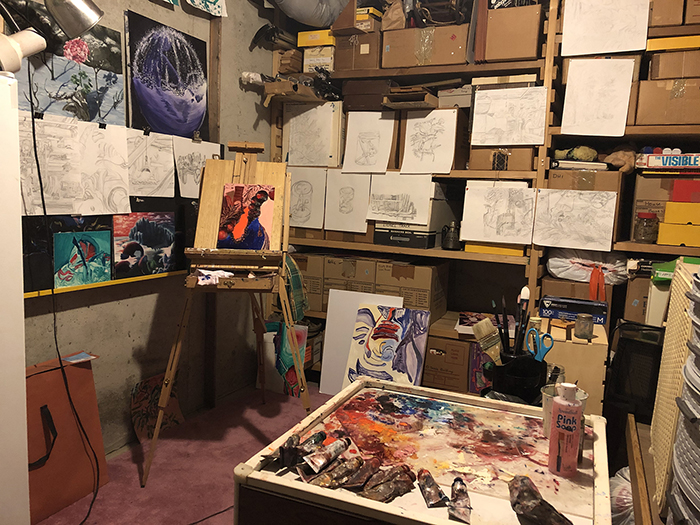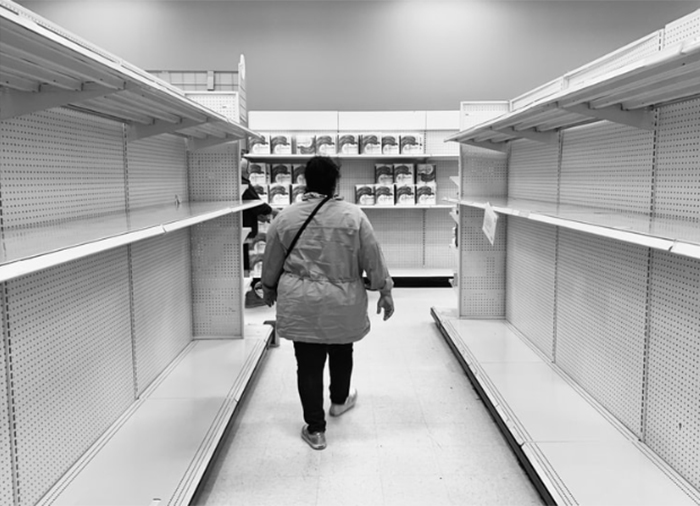Coronavirus Altered the Processes, Venue and Work, But the Senior Art Exhibition Blazes Ahead

Studio-art majors in the class of 2020 had some special challenges as they prepared their exhibition. They met them with fierce creative force.
Senior exhibition, reception and catalogue go digital in light of COVID-19
by MaryAlice Bitts-Jackson
Graduating studio-art majors at Dickinson College spent all year gearing up for a traditional on-campus exhibition—the culminating event of their college careers. Then the college closed its doors in response to the spread of the coronavirus (COVID-19) pandemic, forcing them to reexamine every aspect of their creative processes, their joint planning meetings, their creative work and the ways they would present it. As artists, they’ve responded creatively, often reflecting the practical challenges and the mood of the current moment in their work.
You can see an online exhibition this Friday, May 8, and there will be a private art-exhibition reception that evening at 6 p.m. on Zoom.
New spaces, new approaches
A signature feature of Dickinson’s studio-art program, the annual senior exhibition represents the culmination of all that studio-art majors have learned at Dickinson. This year's model, aptly titled Empty Studio, features the work of graduating seniors Meggie Bromberg, Caitlin Castineiras, Shiyi Chen, Jonathan De Anda, Bryce Delaney, Elizabeth Gallo, Sarah House, Karissa Kendricks, Zoe Josephina Moon Kiefreider, Alice Kuklina, Cecelia Lamancusa, Rose McAvoy, Peter Skutt and Erin Wen.
The easiest transition, when the college closed temporarily after spring break, was the move from in-person weekly meetings and informal critiques with colleagues and professors to email, text and videoconference check-ins. While it was certainly easier to pop in professors' and fellow students' studios when they were all working in the same building, email, text and videoconference technologies did the trick.

Sarah House '20 was working on large-scale paintings in her Goodyear studio at Dickinson. In her home-basement studio, she's scaled back to smaller works, and has begun sketching the objects she sees around her.
Far more challenging was finishing up artwork at home, without access to their private, spacious art studios on campus or to art-department facilities, such as the ceramics and sculpture studios.
“The process of relocating has been pretty impactful for all of us,” says House, who had a large, elaborate setup in her Goodyear Gallery studio, by which she used shards of glass to create distorted views of spaces that she then painted. “I had to almost completely shift gears.”
Unable to transport her studio setup, and without the space at home to paint on a large scale, House carved out a working space in her basement and began to sketch tools and other household objects surrounding her as she developed ideas for smaller-scale works. And it worked.
Another difficulty was figuring out how to best present 3-D works on a 2-D screen.
Castineiras was just finishing up her clay sculptures when she moved back home to finish the semester remotely. She placed her completed sculptures in interesting, textural settings—inside and outside of her home—and photographed them, rendering her final works in a website-friendly 2-D format. “Photography is not what my work typically consists of. But I have been happy with the results,” she says.

Zoe Josephina Moon Kiefreider '20's photography focuses on the effects of COVID-19 on people of color in her community.
Kiefreider, a double major in political science and art, had traveled to Spain during spring break and spent two weeks in quarantine in a hotel on her return to her home city, Los Angeles. By the time she was allowed to go home, in late March, all of the art stores were closed, and she was unable to buy art supplies.
Also worried that her 3-D work would not translate well to the 2-D online exhibition, and lacking space to work on her sculptures, she switched mediums, borrowing a camera from a fellow Posse Scholar friend and taking photos of her sculptures. She also completely changed her subject, by using her camera to document her community in the midst of the pandemic, so that future generations would have historical accounts of the event.
“My photos are specifically focused on people of color in my community, because brown and black people are dying at disproportionate rates from this virus,” she says. “This pandemic gave me a chance to document the social landscape. I am proud of the work that came out of all of this because I think it is a very important job to be an artist right now.”
The show must go on
The final step was showing their works publicly. Rather than hanging works in The Trout Gallery, the students created individual artist's webpages, corralled by a landing page that offers a seamless and unified presentation, along with the digital catalogue. The artists will celebrate their accomplishments and discuss their works during the private Zoom reception.
“I am excited to hear what my classmates have to say about their work,” says House. “We have all been responding to different crazy experiences in the last few weeks, and with everyone coming from different places, literally and figuratively, I think this year's exhibition is going to be one of the most diverse Dickinson has seen.”
“I am lucky to have such supportive professors who have gone above and beyond to help me in these trying times," Kiefreider says. "I cannot express my gratitude enough to Anthony Cervino and Todd Arsenault; they are excellent models of what it means to be resilient, supportive and constructive.”
TAKE THE NEXT STEPS
Published May 7, 2020